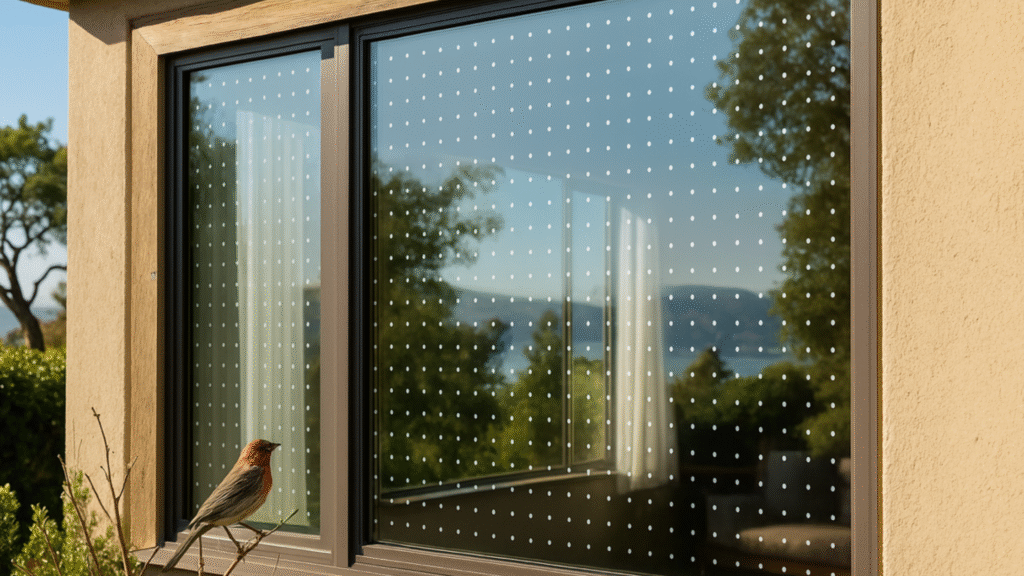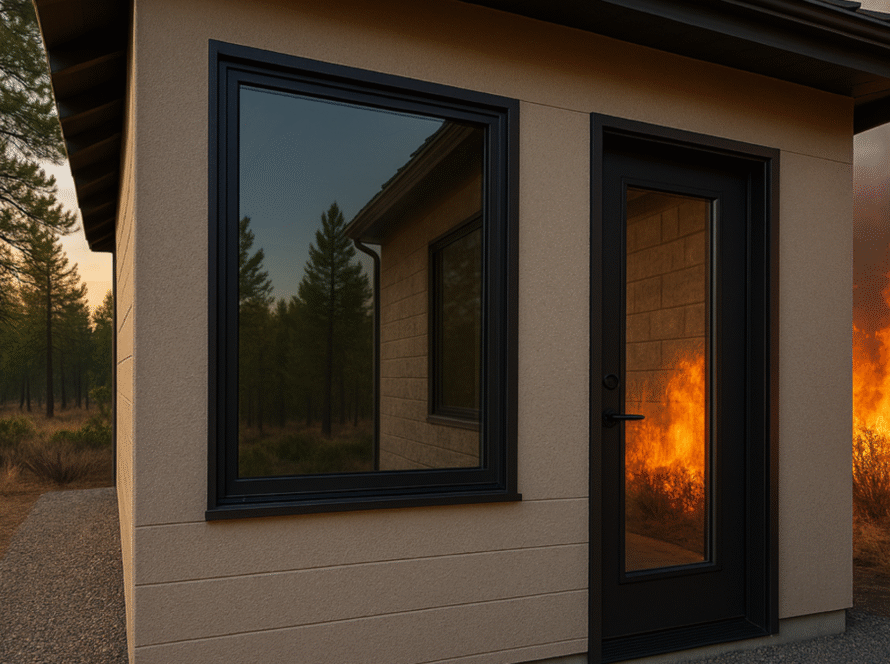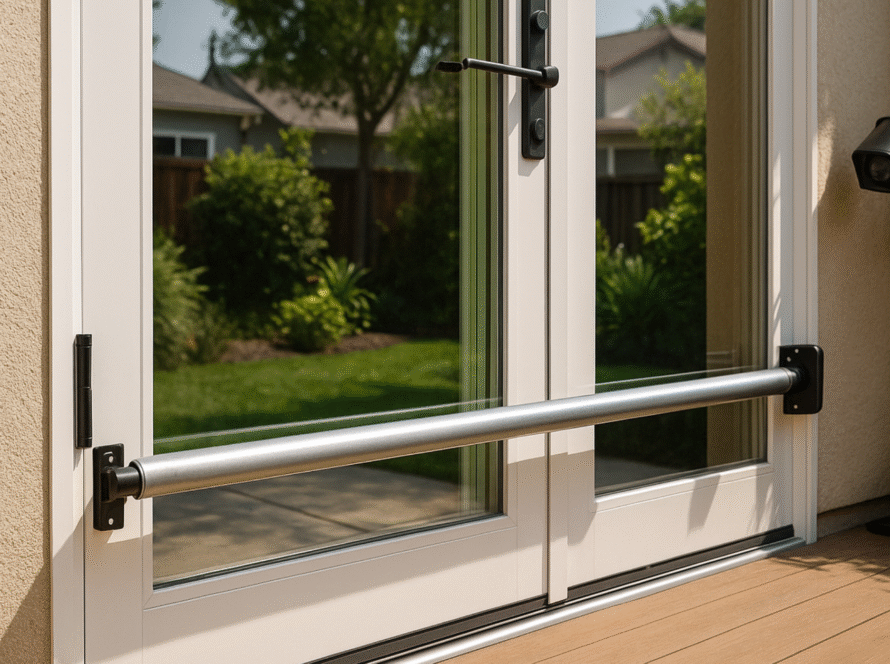
Effective window protection from birds saves wildlife while maintaining your home’s views and natural light in the San Francisco Bay Area’s diverse bird habitats.
Understanding the Problem
Window protection from birds addresses a serious wildlife issue affecting Bay Area homes. Up to 1 billion birds die from window strikes in the United States each year, according to research by ornithologists. The San Francisco Bay Area, with its Pacific Flyway and diverse bird populations, experiences significant numbers of window collisions during spring and fall migrations.
Birds don’t see glass. They see reflections of trees, sky, or vegetation that appear as safe flight paths. Bay Area homes near parks, gardens, or natural areas face a particular risk of bird collisions as birds fly between feeding areas and shelter.
The good news is that simple, affordable solutions can make your windows bird-safe without sacrificing views or natural light. Understanding why birds collide with windows helps you implement effective protection strategies.
Why Birds Strike Windows
Birds typically crash into windows because they see reflections of vegetation or sky in the glass. Picture windows, paired windows at corners, and reflective glass create the most dangerous conditions. Birds mistake these reflections for actual habitat and fly directly into the glass.
Through-window visibility creates another hazard. When birds see through glass to potted plants or vegetation on the other side, they perceive a clear flight path. This “tunnel effect” causes collisions as birds attempt to fly through homes to reach visible greenery beyond.
Collisions occur most frequently at dawn and dusk during spring and fall migration. Migratory birds descending at dawn to rest and feed face risks of window strikes as they navigate unfamiliar urban landscapes. Bay Area’s coastal fog can exacerbate problems by attracting birds off course and into residential areas.
Effective Protection Methods
External Treatments
Bird-safe windows require treatments applied to the outside surface where birds approach. Internal solutions remain invisible when strong reflections appear on exterior glass, rendering them ineffective at preventing bird collisions.
Decals and Dots: Apply decals or dots to exterior glass in patterns spaced no more than 2 inches apart vertically and horizontally. This spacing prevents even small birds, such as hummingbirds and kinglets, from attempting to fly through gaps. Random placement of a few decals doesn’t work—coverage must be comprehensive across the entire window.
Tape Patterns: Specialized bird-deterrent tape comes in translucent designs that allow visibility from inside while creating visible barriers for birds outside. Apply tape in vertical or horizontal strips spaced 2-4 inches apart. White or light-colored tape performs best because it reflects light and provides contrast against varied backgrounds.
Tempera Paint or Soap: For temporary or seasonal protection, mark windows with tempera paint or soap bars. Create grid patterns with 2-inch spacing across the entire outer surface. This inexpensive method works well but requires reapplication after heavy rain.
Hanging Deterrents
Paracord Curtains: Also called “zen curtains,” these closely spaced cords hang vertically in front of windows. Spacing cords 4 inches apart creates effective barriers due to their three-dimensional visibility. These solutions install easily, look attractive, and can be removed when needed.
Screens: Installing standard mosquito screens on the outside of windows provides excellent protection. The mesh breaks up reflections while allowing air circulation. Ensure screens are taut so birds bounce off rather than impacting the glass behind.
Consider bird-friendly features when planning window upgrades. Consult window replacement contractors about glass options and treatments that protect Bay Area wildlife while enhancing your home.
Window Films
One-Way Film: Transparent films make windows appear opaque from outside while allowing clear views from inside. These products reduce reflections that confuse birds. Some films also block UV light and reduce cooling costs—a benefit in the Bay Area’s sunny microclimates.
UV-Reflective Film: Specialized films reflect ultraviolet light that most songbirds can see but humans cannot. These films create visible patterns to birds while remaining nearly invisible to people. Note that some bird species, like Mourning Doves, don’t see UV light, so these films don’t protect all species.
Frosted or Patterned Film: Films with visible patterns, dots, or frosted sections break up reflections while adding privacy. These work particularly well for bathroom or bedroom windows where privacy matters.
Permanent Solutions
Architectural Features
External Screens: Install fixed screens on window exteriors during new construction or remodeling. These prevent collisions while providing insect protection and reducing solar heat gain.
Shutters and Awnings: External shutters or awnings block reflections when closed or extended. They also provide energy savings by shading windows during hot weather. Bay Area’s mild climate makes these features practical year-round.
Exterior Sun Shades: Motorized exterior shades offer convenient control over reflection management. Lower shades during peak bird activity periods—dawn and dusk—while raising them when desired for maximum light and views.
Glass Selection for New Windows
When working with window installation contractors on replacement or new construction window installation projects, consider bird-friendly glass options:
Patterned Glass: Glass with built-in patterns, dots, or etching visible to birds provides permanent protection. These patterns reduce reflectivity while maintaining adequate light transmission.
Fritted Glass: Ceramic frit patterns baked into glass during manufacturing create durable bird deterrents that never wear off or require maintenance.
Angled Installation: Installing windows at slight angles reduces reflections by directing reflected light downward rather than toward flight paths.
Identifying Problem Windows
Not all windows pose equal danger. Start by identifying high-risk locations:
Large Picture Windows: Expansive glass areas create the most reflection and see-through hazards. These should be your first priority for treatment.
Corner Windows: Paired windows at right angles create reflection patterns that confuse birds attempting to navigate around buildings.
Windows Near Feeders: Bird feeders attract wildlife directly toward windows. Treat any windows within view of feeding stations.
Ground-Level Glass: Lower windows near gardens, landscaping, or water features face a higher risk of collisions as birds fly at lower altitudes.
Walk outside and view your windows from various angles. If you see sky, trees, or vegetation reflected in or visible through the glass, birds see the same illusions.
Bay Area Considerations
The San Francisco Bay Area’s location on the Pacific Flyway increases window-strike risks during spring and fall. Millions of birds pass through the region annually, many stopping at Bay Area parks, gardens, and natural areas.
Benicia’s location near the Carquinez Strait creates excellent bird habitat. Waterbirds, raptors, and songbirds frequent the area year-round. Protecting your windows helps conserve these populations.
Fog-prone neighborhoods see increased collision risks. Birds flying in poor visibility rely more on visual cues and become disoriented by artificial lights and window reflections. Morning fog combined with dawn bird activity creates particularly hazardous conditions.
Implementation Strategy
Start with high-priority windows where you’ve observed strikes or near areas with the most bird activity. Apply one of the external treatments described above, following the proper spacing guidelines.
Monitor results over several weeks. If collisions continue, reassess coverage and add treatments to other windows. Most homeowners find that treating just a few problem windows stops most strikes.
Budget-conscious homeowners can start with inexpensive solutions, such as soap or tempera paint, while evaluating longer-term options. These temporary treatments protect birds immediately while you plan permanent solutions.
Protecting Bay Area Birds
Window protection from birds requires simple steps that can make a significant difference in wildlife conservation. Bay Area homeowners can dramatically reduce bird strikes by installing proper window treatments while maintaining home aesthetics and functionality.
The American Bird Conservancy and other organizations continue researching effective solutions and helping homeowners implement bird-safe practices. Following proven spacing guidelines and applying treatments to exterior glass surfaces prevents most collisions.
Consider bird protection when planning window replacement or new construction projects. Working with experienced professionals who understand both building performance and wildlife conservation creates homes that benefit both occupants and the Bay Area’s diverse bird populations.
Take action now to make your windows bird-friendly. The solutions are affordable, effective, and essential for protecting the millions of birds that make the San Francisco Bay Area home or a stopping point during migration.
Since 1987, Insight Glass has provided top-quality windows & patio doors in the Bay Area.
Call 707-746-6571 for Expert Installation!
CONTACT US TO GET A FREE ESTIMATE!


